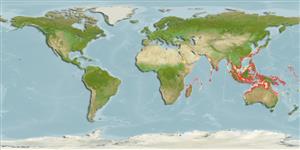Environment: milieu / climate zone / depth range / distribution range
Ecologia
marino; salmastro demersale; amfidromo (Ref. 51243); distribuzione batimetrica 1 - 40 m (Ref. 3424). Tropical
Indo-West Pacific: coasts of India and Sri Lanka to China; south to Australia.
Length at first maturity / Size / Peso / Age
Maturity: Lm 18.1 range ? - ? cm
Max length : 18.2 cm FL maschio/sesso non determinato; (Ref. 46605); common length : 11.0 cm TL maschio/sesso non determinato; (Ref. 3424)
Short description
Chiavi di identificazione | Morfologia | Morfometria
Spine dorsali (totale) : 8; Raggi dorsali molli (totale) : 16; Spine anali: 3; Raggi anali molli: 14. Body silvery; live or fresh specimens with a golden gleam. Head naked; with nuchal spine. Protracted mouth pointing downward. Scales minute. 2nd dorsal spine less than 1/3 of body depth.
Lives in shallow waters down to depths of about 40 m, predominantly near the bottom, found in schools. Feeds mainly on diatoms, copepods, Lucifer, nematodes and polychaetes (Ref. 3424).
Life cycle and mating behavior
Maturities | Riproduzione | Spawnings | Egg(s) | Fecundities | Larve
Kühlmorgen-Hille, G., 1974. Leiognathidae. In W. Fischer and P.J.P. Whitehead (eds.) FAO species identification sheets for fishery purposes. Eastern Indian Ocean (fishing area 57) and Western Central Pacific (fishing area 71). Rome, FAO. Vol. II, pag. var. (Ref. 2108)
IUCN Red List Status (Ref. 130435)
Threat to humans
Harmless
Human uses
Pesca: commerciale
Strumenti
Special reports
Download XML
Fonti Internet
Estimates based on models
Preferred temperature (Ref.
123201): 24.6 - 29.2, mean 28.2 °C (based on 1182 cells).
Phylogenetic diversity index (Ref.
82804): PD
50 = 0.5039 [Uniqueness, from 0.5 = low to 2.0 = high].
Bayesian length-weight: a=0.01318 (0.00799 - 0.02176), b=2.99 (2.84 - 3.14), in cm total length, based on LWR estimates for this species & (Sub)family-body (Ref.
93245).
Trophic level (Ref.
69278): 3.0 ±0.33 se; based on food items.
Resilienza (Ref.
120179): Alto, tempo minimo di raddoppiamento della popolazione meno di 15 mesi (K=0.90-1.75).
Fishing Vulnerability (Ref.
59153): Low vulnerability (15 of 100).
